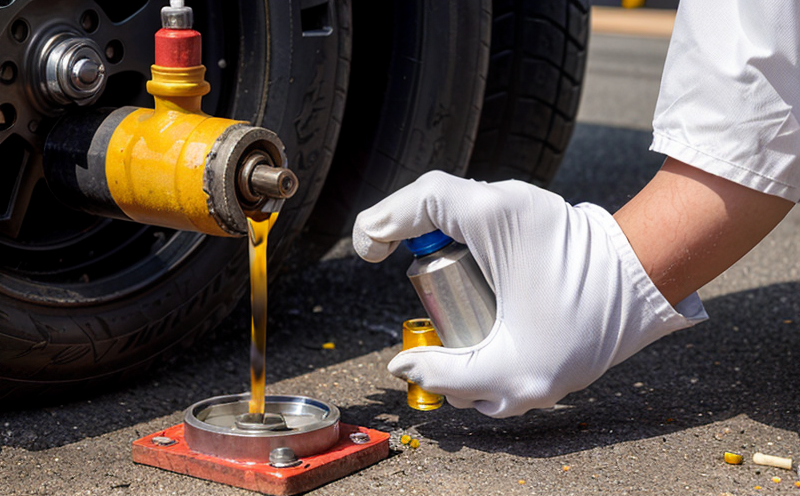ASTM D2622 Sulfur Content Testing by X-ray Fluorescence
The ASTM D2622 standard specifies a method for determining sulfur content in petroleum products and their fractions using X-ray fluorescence (XRF) analysis. This procedure is particularly important in the marine sector, as it ensures compliance with environmental regulations regarding fuel quality. The testing process involves several critical steps that are essential to obtaining accurate results.
The specimen preparation begins by ensuring the sample is representative of the batch being tested. For ASTM D2622, this typically means taking a subsample from the bulk fuel or oil and preparing it in accordance with the standard’s requirements. The preparation process includes drying the sample if necessary to remove any moisture that could interfere with the XRF analysis.
The XRF instrument used for this testing is calibrated according to ASTM D2622, which specifies the need for regular calibration checks to ensure accuracy and precision. Calibration involves using standard reference materials (SRMs) that are traceable to international standards like ISO or ASTM. Once the instrument is properly set up and calibrated, the sample is placed on the instrument’s sample holder.
The XRF process works by bombarding the sample with high-energy X-rays, which causes atoms in the sample to emit secondary X-rays. The energy of these emitted X-rays corresponds directly to the atomic number of the elements present in the sample. By analyzing the intensity and energy of these emissions, it is possible to determine the concentration of sulfur (and other elements) within the fuel or oil.
The results from the XRF analysis are then compared against the acceptance criteria specified in ASTM D2622. These criteria ensure that the sulfur content falls within acceptable limits for marine fuels and lubricants, which helps prevent engine wear and degradation. Compliance with these standards is crucial to maintaining the integrity of marine equipment and ensuring environmental sustainability.
ASTM D2622 testing by XRF offers several advantages over other methods, including its ability to provide rapid results without the need for destructive sample preparation. The method is also highly precise and can detect trace amounts of sulfur, making it ideal for monitoring fuel quality in real-time. This capability is particularly valuable in the marine sector where maintaining optimal engine performance is critical.
In conclusion, ASTM D2622 sulfur content testing by X-ray fluorescence is a vital tool for ensuring compliance with international standards and regulations. Its accuracy, precision, and speed make it an indispensable part of quality control processes within the marine industry.
Why It Matters
The importance of ASTM D2622 sulfur content testing by X-ray fluorescence cannot be overstated, especially in sectors like maritime transportation where environmental impact and operational efficiency are paramount. The sulfur content in fuels directly impacts the performance and longevity of ship engines, as well as the emissions produced during operation.
- Environmental Impact: Higher sulfur levels lead to increased exhaust emissions, which can contribute to air pollution and harm aquatic ecosystems when discharged into waterways.
- Engine Performance: Excessive sulfur content in fuels can cause corrosion and wear on engine components, leading to higher maintenance costs and potential breakdowns at sea.
- Regulatory Compliance: Meeting international standards like those set by ASTM ensures that marine fuel meets the stringent requirements imposed by maritime authorities worldwide.
In summary, accurate sulfur content testing is essential for maintaining both environmental sustainability and operational reliability in the maritime industry. By adhering to these tests, ship operators can ensure their vessels are equipped with fuels that meet regulatory standards while minimizing maintenance costs and emissions.
Benefits
- Precision: The ASTM D2622 method using XRF provides highly precise results, allowing for accurate measurement of sulfur content even in trace amounts.
- Rapid Results: XRF testing is fast and efficient, enabling quick turnaround times which are crucial for quality control processes.
- Non-Destructive: Unlike some other analytical methods, ASTM D2622 by XRF does not require the destruction of samples, preserving their integrity for further analysis if needed.
- Comprehensive Analysis: The method can also provide additional elemental information beyond just sulfur content, offering a more comprehensive view of fuel composition.
The combination of these benefits ensures that operators and manufacturers can make informed decisions regarding fuel selection and quality control, ultimately leading to cost savings and improved operational efficiency.
Quality and Reliability Assurance
- Calibration: Regular calibration of the XRF instrument according to ASTM D2622 ensures that all measurements are accurate and reliable. This includes using standard reference materials traceable to international standards.
- Data Validation: Results from each test run are cross-verified with previous data and compared against industry benchmarks to ensure consistency and reliability.
The laboratory adheres strictly to ASTM D2622 guidelines, employing experienced technicians and state-of-the-art equipment to maintain the highest standards of quality and reliability. This commitment ensures that every test result is both precise and reliable, providing clients with confidence in their fuel selection and compliance efforts.





